-
Posts
741 -
Joined
-
Last visited
Content Type
Forums
Profiles
Store
Gallery
Articles
Blogs
Events
Downloads
Posts posted by Billena
-
-
This 42-year-old patient underwent a craniotomy for a malignant brain tumor. Her recovery from this illness was successful. However, she was reminded of this unpleasant chapter on a daily basis because of the scar atop her head.
She underwent an FUT procedure with Dr. Wesley in which 1696 grafts were transplanted into and around the region of scarring. She can be seen before and 17 months after her FUT procedure.











-
Thank you John.
Yes, this patient is VERY happy with his results!!!!
-
This 29-year-old patient had prior FUE sessions in the frontal region and midscalp areas of his crown. The FUE procedures included beard FUE grafts into his midscalp. He desired more hair in his crown, but his donor reserve was limited and - in his 20s - he was almost certain to have more thinning in his donor region.
This patient received 2 PRP sessions as well as the daily use of the topical hair growth blend (HGB) provided by Dr. Wesley. The images depict the patient before and about one year after initiating this non-surgical therapy.
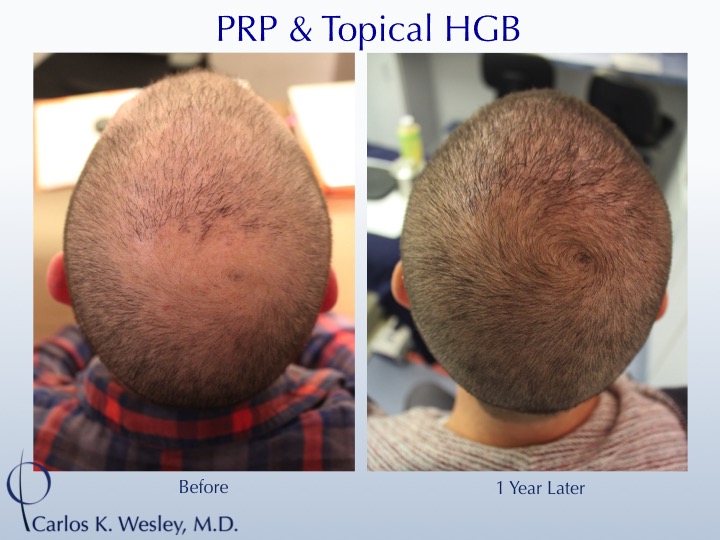
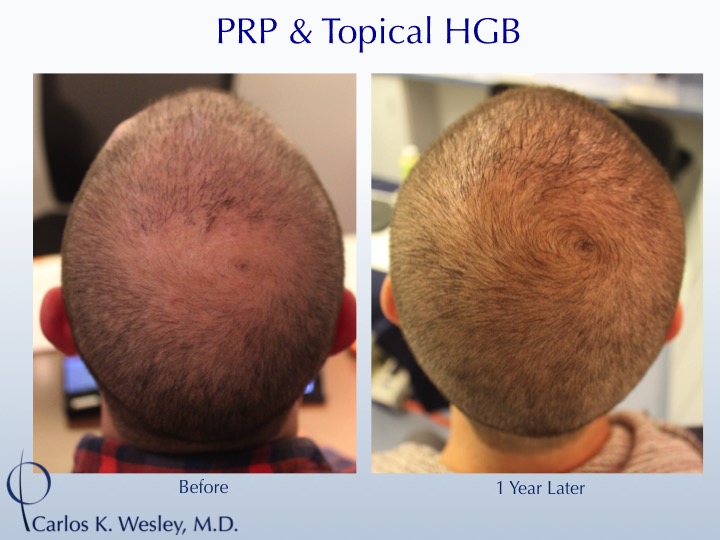
-
Thank you all for your kind words. This was truly a great example of how a hair transplant should look after 10 years- very natural!
-
-
You are correct-should have been improve hairline.
Thank you for pointing this out!
-
Spanker- you are so right- I will correct that in the future.
Thank you!
-
This 27-year-old man underwent a follicular unit extraction (FUE) session with Dr. Carlos K. Wesley in which a total of 2000 grafts were placed.
His hair follicles were incubated in autologous (his own) platelet rich plasma (PRP) throughout the duration of the procedure. This, combined with an ATP-containing storage solution has been shown to enhance survival of transplanted hairs.
Rather than a larger FUE punch used by a robotic approach, Dr. Wesley used a smaller caliber hand-held motorized punch to performed the donor harvest. This approach better enabled the capture of donor hair roots that are slightly curved beneath the skin surface. Upon completion of the harvest, the patient’s donor area was treated with PRP and ACell in order to not only minimize scar tissue formation, but also encourage partial regeneration of donor hair follicles.
The patient returned one year after his procedure and images of the patient can be seen below.





-
Hi,
I'm sorry but we didn't get the email.
Please call me at 844-745-6362 so I can set that up for you!
-
Hi Spanker,
Thank you for contacting us but we checked on another computer and the pictures do show-they're just very far down from the base of the post.
-
This 48-year-old woman lost much of her hair 10 years ago in the frontal region (forehead and temporal areas). She can be seen before and only 7 months after a 1935 graft FUT session with Dr. Wesley.
The purpose of this session was to create a healthy framing of her face. During the process of early growth (prior to a year post transplantation), the design can be heightened by the use of a scalp concealing powder (as she is using in this image). This new framing of her face has allowed her to wear her hair in virtually any style that she chooses!






-
This 29-year-old man underwent a follicular unit extraction (FUE) session with Dr. Carlos K. Wesley in which a total of 2086 grafts were placed.
His hair follicles were incubated in autologous (his own) platelet rich plasma (PRP) throughout the duration of the procedure. This, combined with an ATP-containing storage solution has been shown to enhance survival of transplanted hairs.
Rather than a larger FUE punch used by a robotic approach, Dr. Wesley used a smaller caliber hand-held motorized punch to performed the donor harvest. This approach better enabled the capture of donor hair roots that are slightly curved beneath the skin surface. Upon completion of the harvest, the patient’s donor area was treated with PRP and ACell in order to not only minimize scar tissue formation, but also encourage partial regeneration of donor hair follicles.
The patient returned one year after his procedure and images of the patient can be seen below.






-
You are so right Spanker- The title should read 1783 grafts. All the rest of the information is correct.
Thank you for bringing that to my attention.
-
This 32-year-old man underwent a follicular unit extraction (FUE) session with Dr. Carlos K. Wesley in which a total of 1783 grafts were placed.
His hair follicles were incubated in autologous (his own) platelet rich plasma (PRP) throughout the duration of the procedure. This, combined with an ATP-containing storage solution has been shown to enhance survival of transplanted hairs.
Rather than a larger FUE punch used by a robotic approach, Dr. Wesley used a smaller caliber hand-held motorized punch to performed the donor harvest. This approach better enabled the capture of donor hair roots that are slightly curved beneath the skin surface. Upon completion of the harvest, the patient’s donor area was treated with PRP and ACell in order to not only minimize scar tissue formation, but also encourage partial regeneration of donor hair follicles.
The patient returned 18 months after his procedure and images of the patient can be seen below.






-
Voxman,
That's pretty funny- thank you for your kind words!
-
This patient underwent a hair restoration surgical procedure with Dr. Wesley just over 10 years ago. As he was a revision of a prior surgery and desired more density and a healthier looking hairline, a combination of FUT and FUE were performed.
With the FUT strip yielding only 1283 grafts due to the tightness of the scalp, an additional 748 grafts were harvested with FUE (both scalp and beard) in order to improve the overall fullness.
The patient returned to see Dr. Wesley about a decade after the procedure was performed and can be seen in the accompanying images.
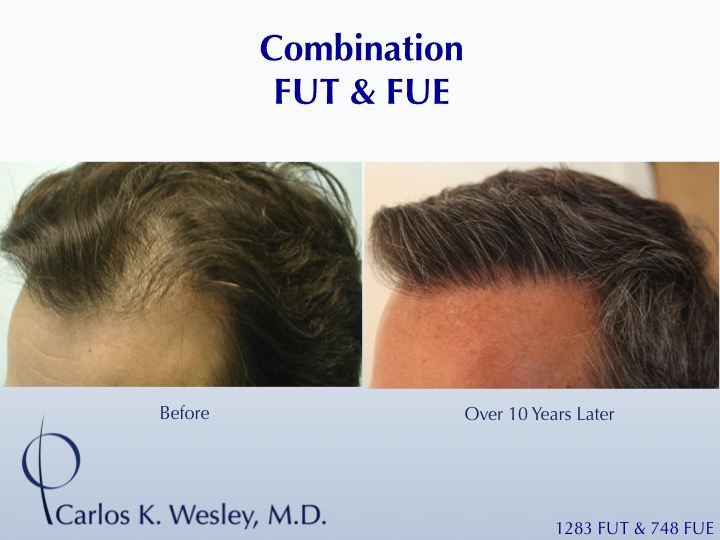

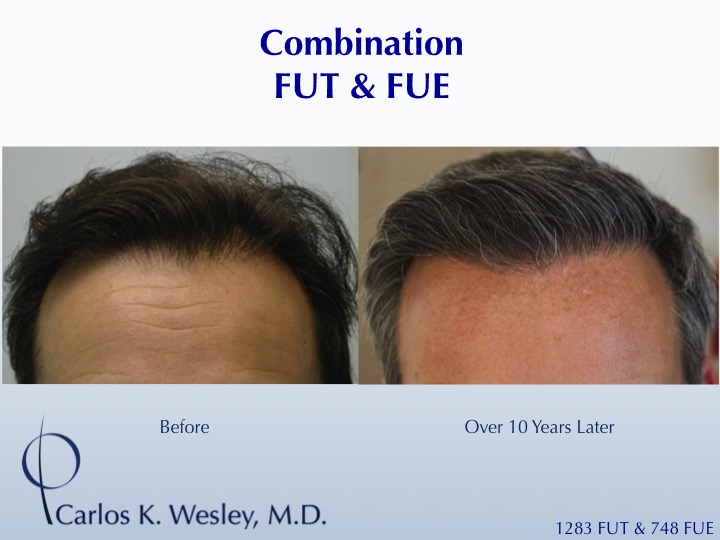
-
This 50-year-old man underwent a follicular unit transplantation (FUT) session with Dr. Carlos K. Wesley in which a total of 2421 grafts were placed.
The patient’s hair follicles were incubated in platelet rich plasma (PRP) throughout the duration of the procedure. This, combined with an ATP-containing storage solution has been shown to enhance survival of transplanted hairs.
As with all of Dr. Wesley’s patients, he was NOT required to cut his hair for the procedure. As a result, this patient was able to return comfortably to work and social activities within approximately 7-10 days of his procedure.
The patient returned one year after his procedure and images of the patient can be seen below.
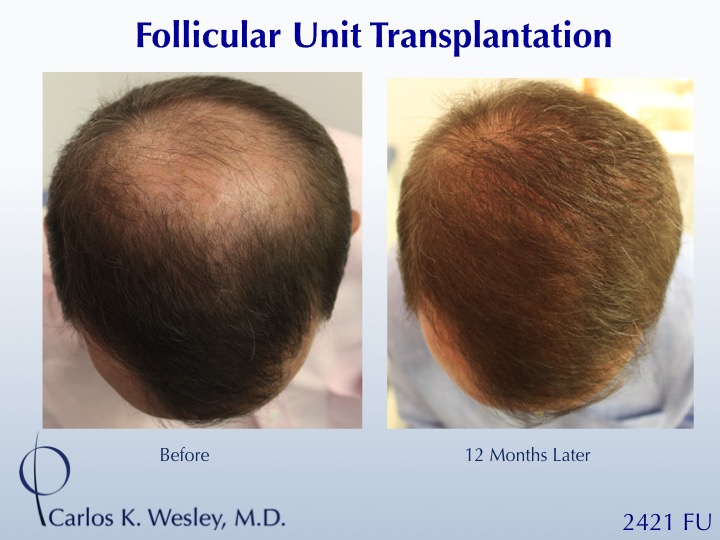
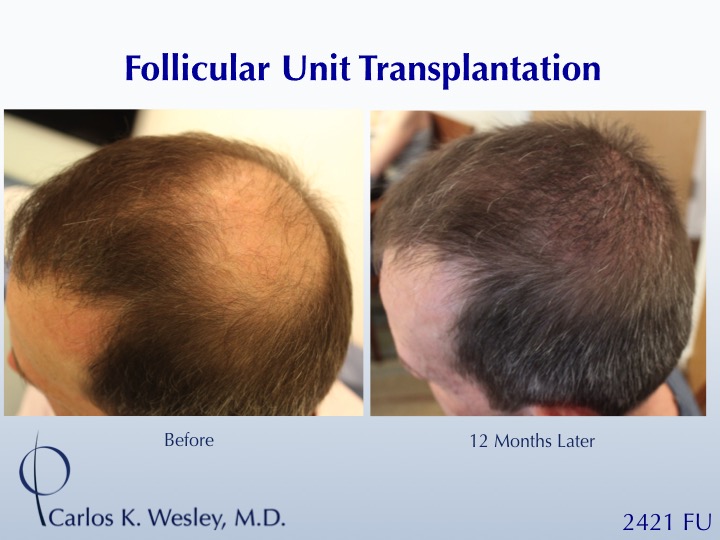
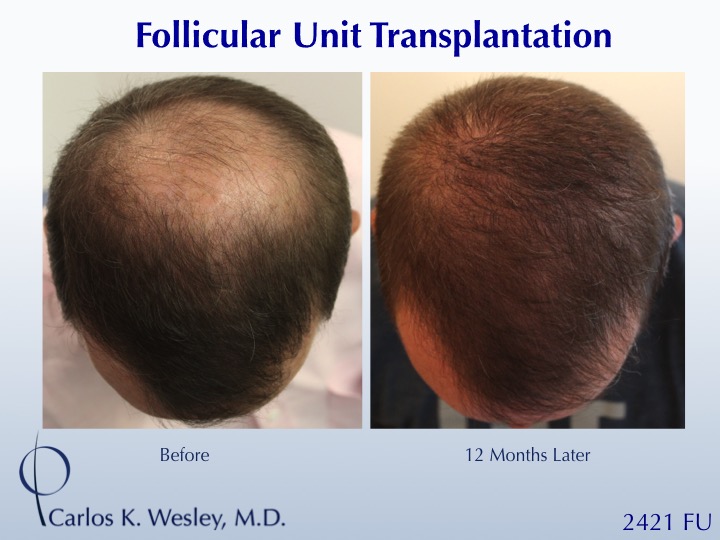
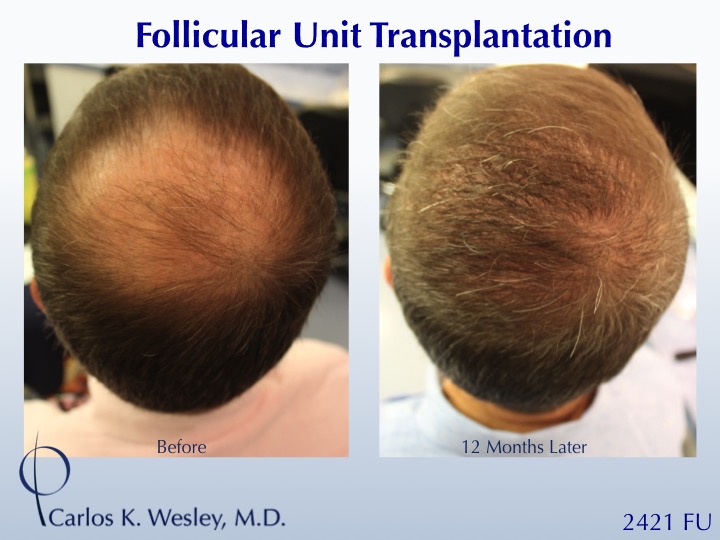
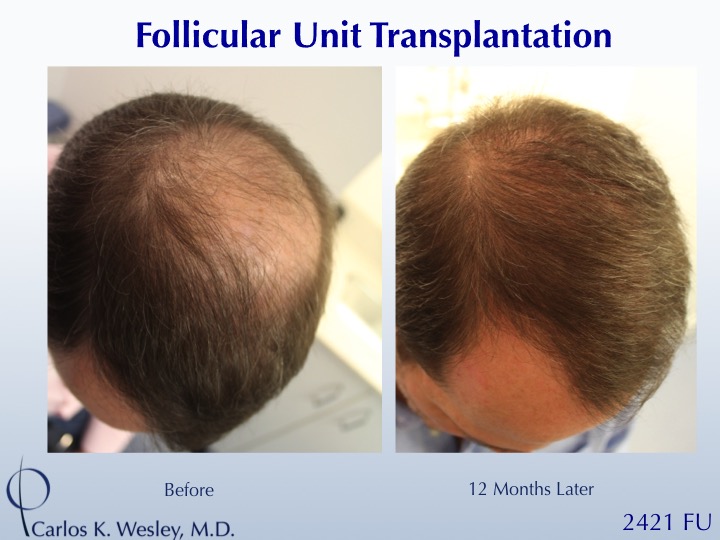
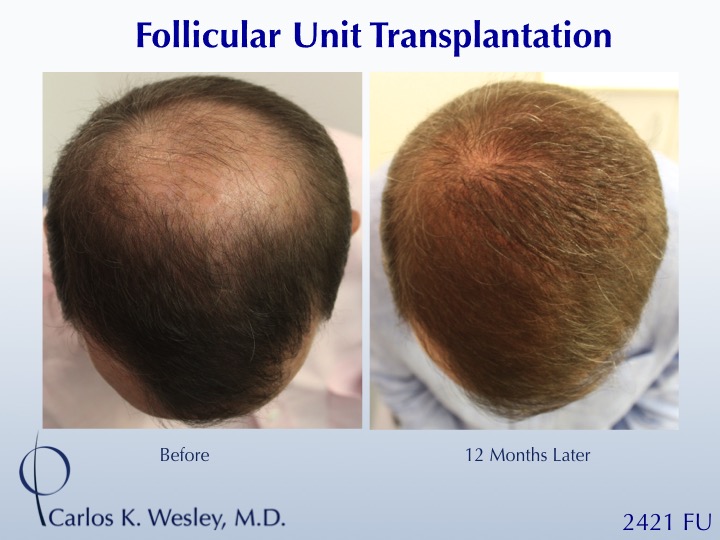
-
This 36-year-old man underwent a follicular unit extraction (FUE) session with Dr. Carlos K. Wesley in which a total of 2111 grafts were placed
His hair follicles were incubated in autologous (his own) platelet rich plasma (PRP) throughout the duration of the procedure. This, combined with an ATP-containing storage solution has been shown to enhance survival of transplanted hairs.
Rather than a larger FUE punch used by a robotic approach, Dr. Wesley used a smaller caliber hand-held motorized punch to performed the donor harvest. This approach better enabled the capture of donor hair roots that are slightly curved beneath the skin surface. Upon completion of the harvest, the patient’s donor area was treated with PRP and ACell in order to not only minimize scar tissue formation, but also encourage partial regeneration of donor hair follicles.
The patient returned one year after his procedure and images of the patient can be seen below.






-
This 35-year-old man underwent a follicular unit transplantation (FUT) session with Dr. Carlos K. Wesley in which a total of 2219 grafts were placed.
The patient’s hair follicles were incubated in platelet rich plasma (PRP) throughout the duration of the procedure. This, combined with an ATP-containing storage solution has been shown to enhance survival of transplanted hairs.
As with all of Dr. Wesley’s patients, he was NOT required to cut his hair for the procedure. As a result, this patient was able to return comfortably to work and social activities within approximately 7-10 days of his procedure.
The patient returned one year after his procedure and images of the patient can be seen below.






-
This 41-year-old man underwent a follicular unit transplantation (FUT) session with Dr. Carlos K. Wesley in which a total of 2421 grafts were placed
The patient’s hair follicles were incubated in platelet rich plasma (PRP) throughout the duration of the procedure. This, combined with an ATP-containing storage solution has been shown to enhance survival of transplanted hairs.
As with all of Dr. Wesley’s patients, he was NOT required to cut his hair for the procedure. As a result, this patient was able to return comfortably to work and social activities within approximately 7-10 days of his procedure.
The patient returned 12 months after his procedure and images of the patient can be seen below
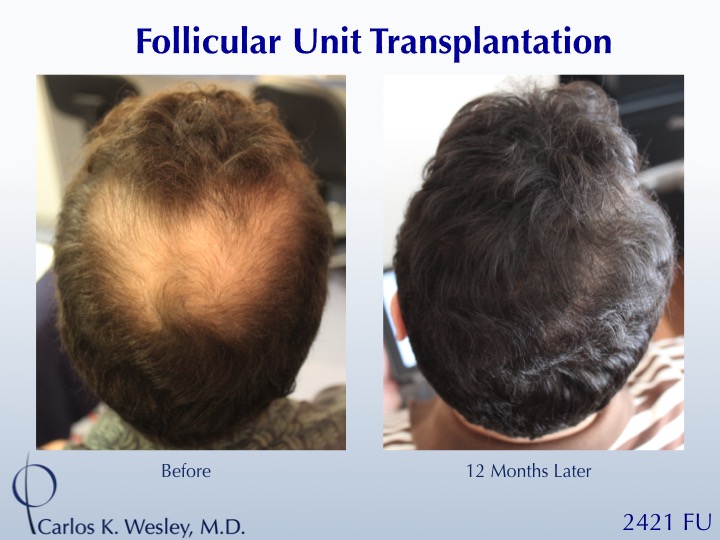
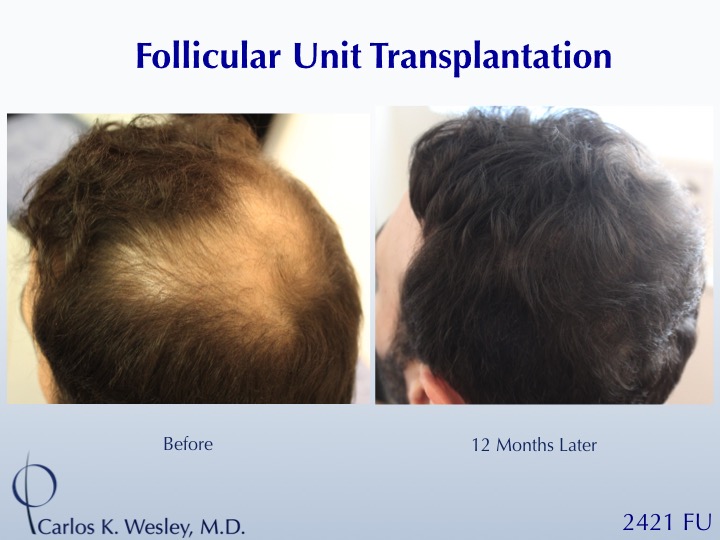
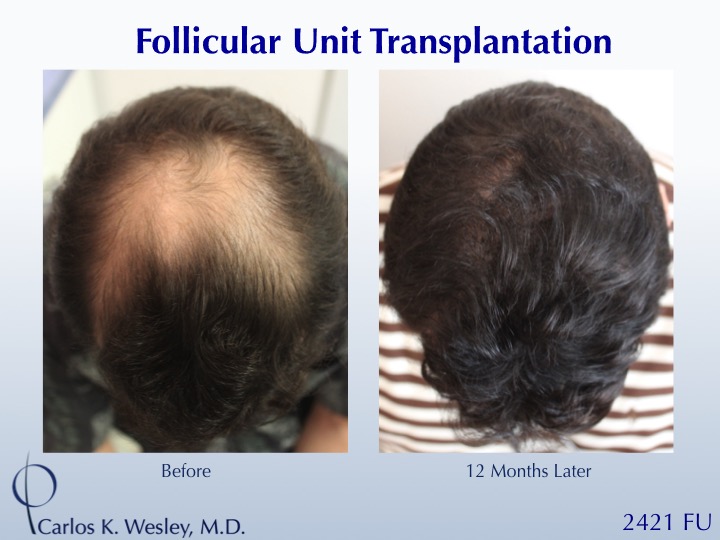
-
This 40-year-old man underwent an autologous (his own) platelet rich plasma (PRP) treatment with Dr. Carlos K. Wesley.
With this non-surgical approach to treating hair loss, he was able to reverse the biologic course of the thousands of miniaturized follicles atop his head and generate more hair fullness. Dr. Wesley previously delivered an in-depth lecture on PRP scalp treatment for genetic hair loss detailing all aspects of this procedure. The benefits and limitations of PRP procedures are described in this video for all interested patients who would like to learn more about this novel therapy.
The patient returned 7 months after his PRP treatment series (involving 2 procedures) and images of the patient can be seen below.



-
This 54-year-old man underwent a follicular unit transplantation (FUT) session with Dr. Carlos K. Wesley in which a total of 2401 grafts were placed
The patient’s hair follicles were incubated in platelet rich plasma (PRP) throughout the duration of the procedure. This, combined with an ATP-containing storage solution has been shown to enhance survival of transplanted hairs.
As with all of Dr. Wesley’s patients, he was NOT required to cut his hair for the procedure. As a result, this patient was able to return comfortably to work and social activities within approximately 7-10 days of his procedure.
The patient returned 11 months after his procedure and images of the patient can be seen below together with the images taken one week postoperatively.
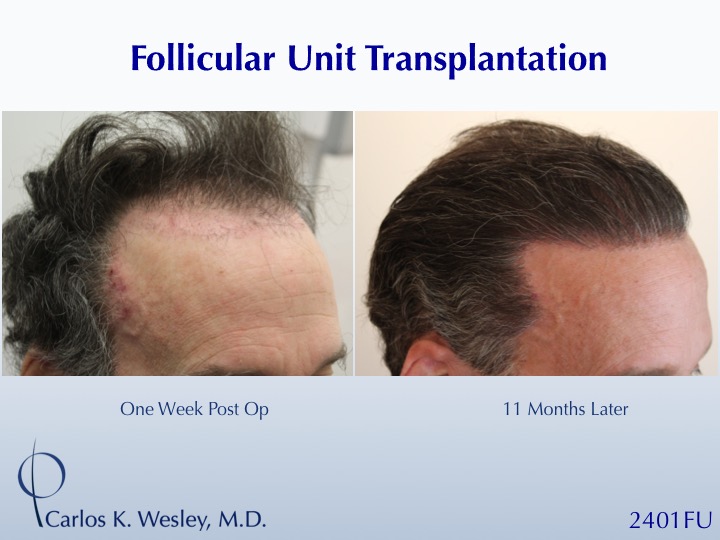

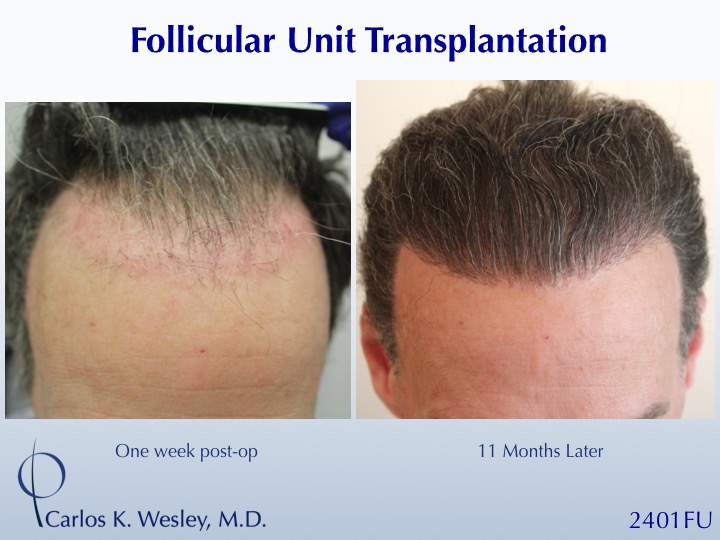
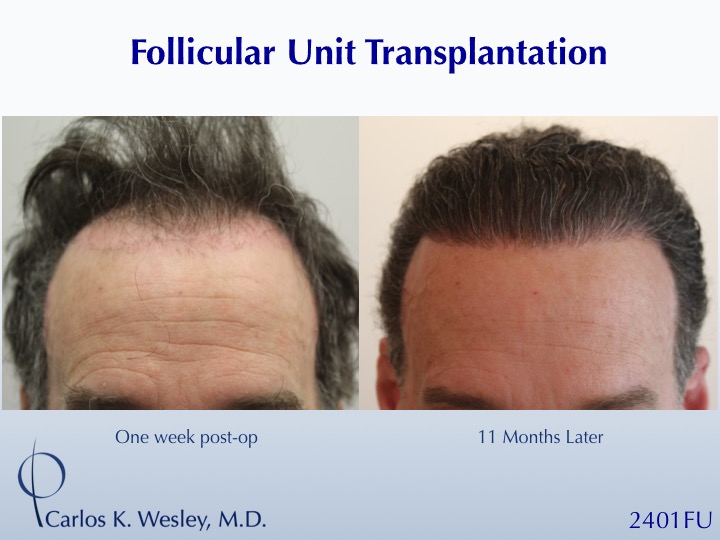
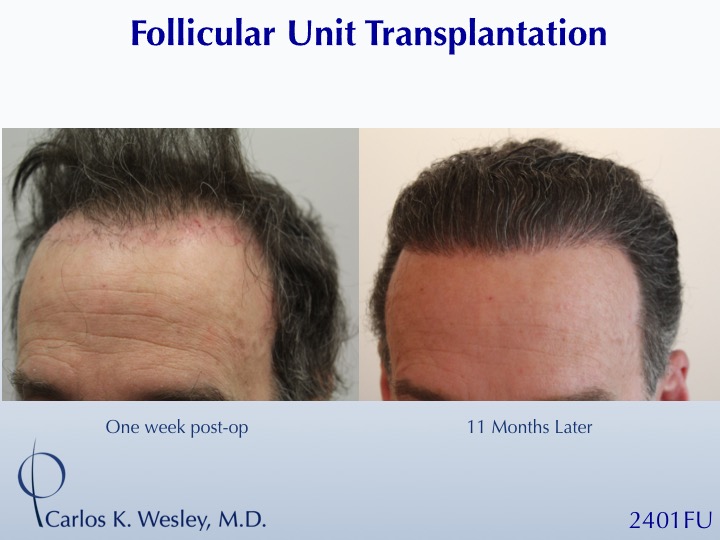
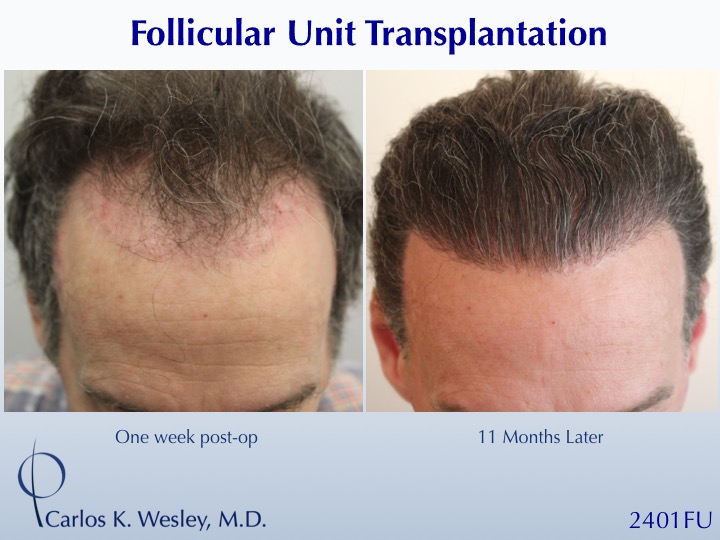
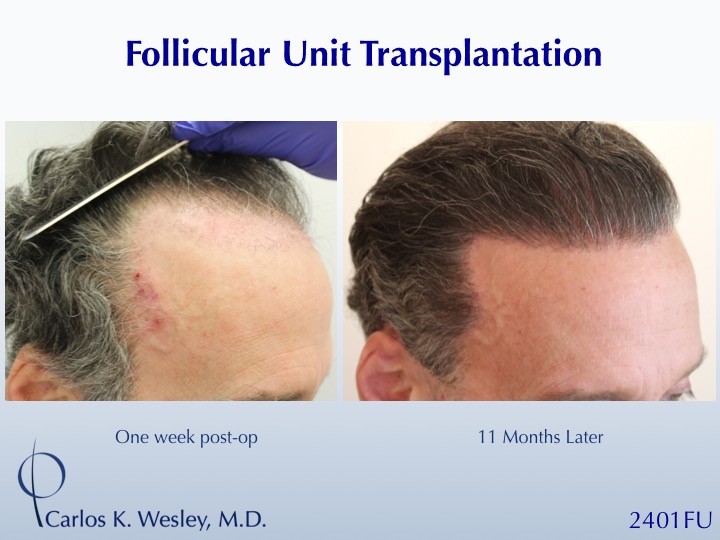
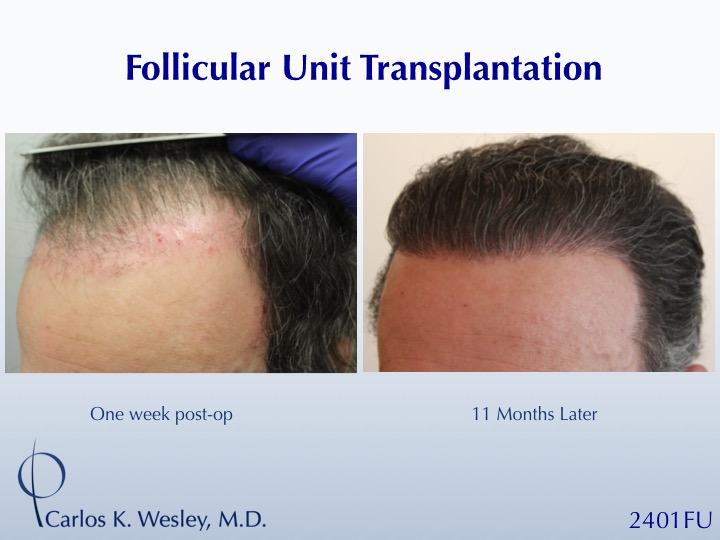
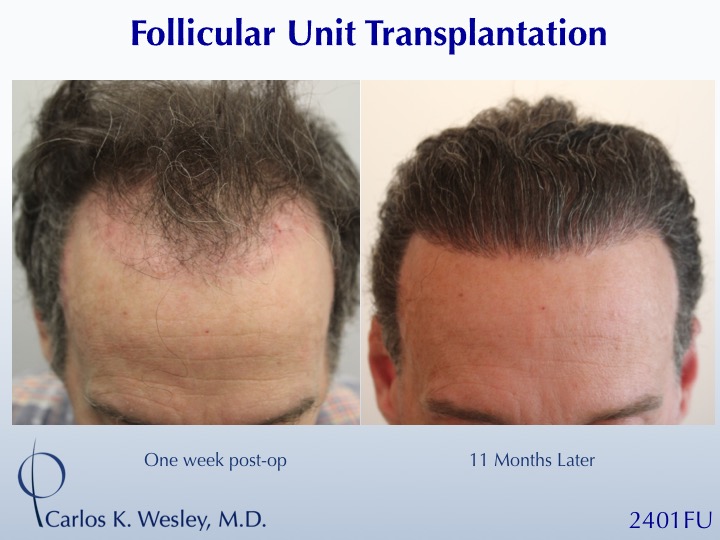
-
This 29-year-old man underwent a follicular unit extraction (FUE) session with Dr. Carlos K. Wesley in which a total of 2657 grafts were placed
His hair follicles were incubated in autologous (his own) platelet rich plasma (PRP) throughout the duration of the procedure. This, combined with an ATP-containing storage solution has been shown to enhance survival of transplanted hairs.
Rather than a larger FUE punch used by a robotic approach, Dr. Wesley used a smaller caliber hand-held motorized punch to performed the donor harvest. This approach better enabled the capture of donor hair roots that are slightly curved beneath the skin surface. Upon completion of the harvest, the patient’s donor area was treated with PRP and ACell in order to not only minimize scar tissue formation, but also encourage partial regeneration of donor hair follicles.
The patient returned one year after his procedure and images of the patient can be seen below.





-
This 31-year-old man underwent a follicular unit transplantation (FUT) session with Dr. Carlos K. Wesley in which a total of 2005 grafts were placed
The patient’s hair follicles were incubated in platelet rich plasma (PRP) throughout the duration of the procedure. This, combined with an ATP-containing storage solution has been shown to enhance survival of transplanted hairs.
As with all of Dr. Wesley’s patients, he was NOT required to cut his hair for the procedure. As a result, this patient was able to return comfortably to work and social activities within approximately 7-10 days of his procedure.
It is important to note the planning involved with this young male patient. In anticipation of future hair loss, the surgical design was rather conservative in order to ensure a natural pattern later in his lifetime even after much of his pre-existing hair has been lost.
The patient returned 1 year after his procedure and images of the patient can be seen below.







Want More Dark Curly Hair? (Carlos K. Wesley, MD)
in Results Posted by Leading Hair Restoration Clinics
Posted
This 44-year-old man underwent a follicular unit transplantation (FUT) session with Dr. Carlos K. Wesley in which a total of 2255 grafts were placed.
The patient’s hair follicles were incubated in platelet rich plasma (PRP) throughout the duration of the procedure. This, combined with an ATP-containing storage solution has been shown to enhance survival of transplanted hairs.
As with all of Dr. Wesley’s patients, he was NOT required to cut his hair for the procedure. As a result, this patient was able to return comfortably to work and social activities within approximately 7-10 days of his procedure.
The patient returned two years after his procedure and images of the patient can be seen below.